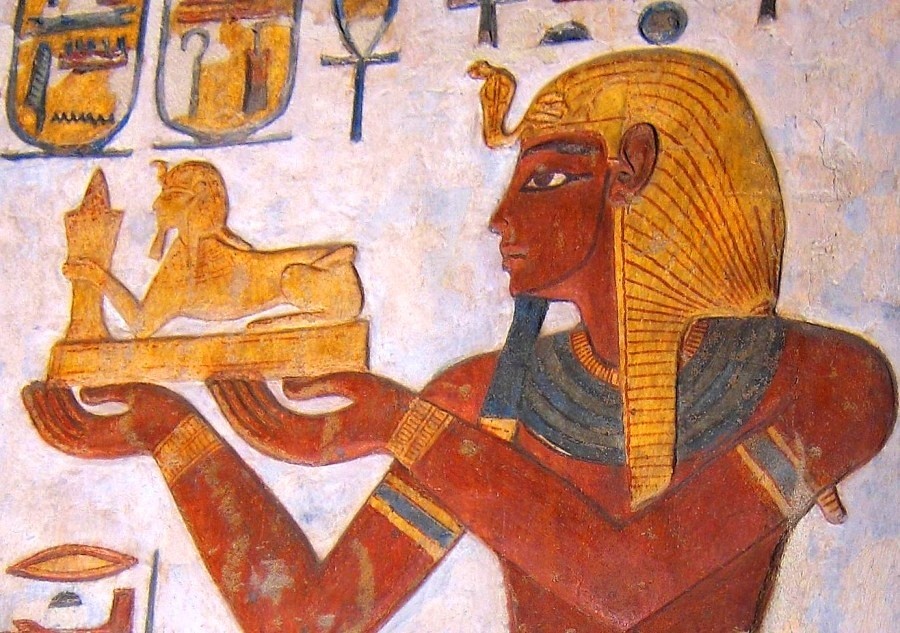 In the eighth year of the reign of Ramesses III (ok. 1192 r. p.n.e.) Black clouds hung over Egypt. The following inscription is placed on the walls of Medinet Habu: “Foreign peoples have established a conspiracy on their islands; they set off immediately and were scattered in the whirlwind of the battle; no country could resist their armed arms; [and regions] Hatti, Card, Karkemis, Arzawa and Alasia [Cyprus] they were stripped of their roots in one blow. [It was broken] their camp somewhere in Amurru; they annihilated his people and his country, as if they had never been there; though the flames spread before them, they came closer, onward towards Egypt […] – they laid their hands on lands that stretched to the very horizon”. It was a huge migration of the so-called. Peoples of the Sea, possibly from the Balkan and Aegean regions, which included numerous communities and tribal groups (Shardans, Palastu -Filistyni, Szikalaju, Turusza, The Danes, Yours). Ni.ef all names have been identified. Some peoples are the ancestors of the Trojans, Etruscans or the later people of Sicily and Sardinia. Ok. 1200 r. p.n.e. the devastation extended from Northern Syria (Ugarit, Alalach) to southern Canaan (Your ass, Ashkelon). Even Cyprus had to surrender. The invading pressure destroyed the Hittite capital Hatussas and caused the empire to collapse. The borders of the Delta had to be quickly secured on land and at sea, for a similar fate threatened Egypt. The peoples of the Sea, impassioned by their successes, pressed forward unstoppably. The reliefs depict them on chariots and on foot. The troops are accompanied by huge carriages with carts drawn by oxen, followed by families of warriors.
In the eighth year of the reign of Ramesses III (ok. 1192 r. p.n.e.) Black clouds hung over Egypt. The following inscription is placed on the walls of Medinet Habu: “Foreign peoples have established a conspiracy on their islands; they set off immediately and were scattered in the whirlwind of the battle; no country could resist their armed arms; [and regions] Hatti, Card, Karkemis, Arzawa and Alasia [Cyprus] they were stripped of their roots in one blow. [It was broken] their camp somewhere in Amurru; they annihilated his people and his country, as if they had never been there; though the flames spread before them, they came closer, onward towards Egypt […] – they laid their hands on lands that stretched to the very horizon”. It was a huge migration of the so-called. Peoples of the Sea, possibly from the Balkan and Aegean regions, which included numerous communities and tribal groups (Shardans, Palastu -Filistyni, Szikalaju, Turusza, The Danes, Yours). Ni.ef all names have been identified. Some peoples are the ancestors of the Trojans, Etruscans or the later people of Sicily and Sardinia. Ok. 1200 r. p.n.e. the devastation extended from Northern Syria (Ugarit, Alalach) to southern Canaan (Your ass, Ashkelon). Even Cyprus had to surrender. The invading pressure destroyed the Hittite capital Hatussas and caused the empire to collapse. The borders of the Delta had to be quickly secured on land and at sea, for a similar fate threatened Egypt. The peoples of the Sea, impassioned by their successes, pressed forward unstoppably. The reliefs depict them on chariots and on foot. The troops are accompanied by huge carriages with carts drawn by oxen, followed by families of warriors.
The garrisons in the east took the first strike. Somewhere at the interface between Egypt and Palestine, a great battle was fought over the land, the result of which determined the fate of the surrounding area for many centuries. They prepared for the fight very carefully: the defensive watts have been strengthened, on which Ramses has located his best troops. An equally great battle was fought at sea near the Eastern Delta, where the Egyptian and Sea Peoples fleets took off. The king blocked the entrance to the Delta with his ships, and on the banks he set up selected units of porkers. Filistyni, who started the attack, they were easily recognizable by their specific headgear with high combs. Enemy ships were rammed in a crush, and some were caught with hooks. As the armies of the Philistines tried to go ashore, were showered with arrows. From the high seas, the crowded boats were struck by an Egyptian force on fast ships, making up the measure of enemy defeat. Some foreign ships sank, others were seized by the Egyptians. Many prisoners were taken. When the fighting stopped, Egyptian scribes set about, carefully noting macabre trophies – cut off hands and genitals of dead enemies, and making mounds of them. Ramesses III and his troops repelled the invasion.
Ramses went north, to central Syria and Amurru. He conquered several Amorite fortresses and there he got acquainted with the structure called the migdol. The reliefs in Medinet Habu today show the ships of the Sea Peoples rammed and turned upside down. The bows and sterns of ships are decorated with the heads of water birds. The fighting Egyptians remembered the appearance and weapons of their enemies: heads covered with plume helmets, round shields, swords and spears and short skirts. On the south stele in Medinet Habu with 12. In the year of Ramses, further victorious battles against the Sea Peoples are mentioned. The prisoners were dragged into the Egyptian army, and the tribes of Palast and Cheker were settled in punishment on the coast of Palestine, where in time they formed the state of the Philistines.